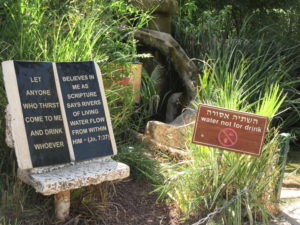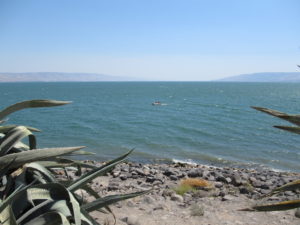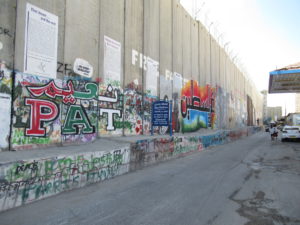Our visit to Israel wasn’t only about Jerusalem. We spent 5 days in the capital city, but twice that many driving around the rest of the country. As with Jerusalem, we did our best to look past the nation’s troubled history and just enjoy the people, the food, and the landscapes.
In most areas that was easy to do. The hills and valleys around the Sea of Galilee, for example, are full of peaceful pastoral towns serving up lots of fresh meat, fish, and vegetables, plus wonderful vistas.
Most of the places we visited in Galilee have deep connections to the New Testament. Capernaum was a small fishing village during the time of Jesus. According to the gospels, Jesus taught in Capernaum’s synagogue and performed miracles there. The town of Tabgha is where – it is said – Jesus fed 5,000 peeps with five loaves of barley bread and two small fish. Mount Eremos, also known as the Mount of the Beatitudes, is where – it is said – Jesus gave the Sermon on the Mount.
All these places have churches that commemorate their Biblical events. In most cases, the churches are relatively new.
A little further south, we visited Nazareth, where Jesus grew up, and Cana, where Jesus turned water into wine at a wedding reception. (I’d like to learn that particular skill.)
We also visited the Dead Sea. Yes, you really do float on the surface without even trying, thanks to the water’s high salt and mineral content.

In some spots, the Dead Sea looks very calm and idyllic, with no hint of its unusually dense composition.
Seems to me the Dead Sea is a place where a person could maybe actually walk on water. By the way, it’s not a sea at all. It’s a lake. Same with the Sea of Galilee. Also a lake. I guess “sea” sounds more impressive.
On the way to the Dead Sea we visited Timna Park, the site of ancient Egyptian copper mines. Some of the mines date back 6,000 years. But the park is most famous for the rock formations known as Solomon’s Pillars. The name is a mistake. The sandstone pillars weren’t carved during Solomon’s reign or as part of any mining operation. They were formed naturally, millions of years before humans hit the scene.
We did go to one other place that, like Jerusalem, has some palpable political tension. Bethlehem is only 20 minutes by car south of Jerusalem. But that proximity isn’t the issue. What can take tourists out of their comfort zone in Bethlehem is the fact that it’s within the borders of the Palestinian Authority. An independent nation, or one that ought to be, in the eyes of 137 other nations. I’m not going to take sides here, but from talking to some Palestinian shopowners and tour guides and taxi drivers, it seems the vast majority of them want peace. But they also want equal footing with Israeli citizens.
People go to Bethlehem mainly to visit the church that – it is said – sits on the spot where Jesus was born in a manger. But I thought the most interesting thing to see in Bethlehem was the Palestinian side of the West Bank wall – or separation barrier, or security fence, or whatever the Israeli government is calling it today. The wall runs for hundreds of miles along the West Bank, and towers over the small town of Bethlehem at a height of 25 feet.
Needless to say, the Palestinians don’t like the wall. They and their allies have other names for it. They call it the Wall of Apartheid, or the Wall of Racial Segregation.
Regardless of where you stand on the politics of the situation, you can admire the creativity of the Palestinian graffiti.
With the exception of the Gaza strip – an area tourists don’t go near for obvious reasons – Israel’s Mediterranean coast is pretty laid back, brushing aside most of the political worries in the east. Haifa in particular is known for being a place where Jews and Arabs get along just fine. It’s also the country’s third-largest city and an economic powerhouse. Haifa has a major seaport, a high-tech industrial park, and large petrochemical refineries. Haifa is also home to the Bahá’í Gardens, the spiritual headquarters of the Bahá’í faith. Tourists flock here to view the impeccably manicured lawns and greenery, and the shrine at the center.
Near Haifa are two seaside towns worth a visit for their old architecture. To the north, Akko, or Acre, features the remnants of a Crusader-era fortress.
To the south, Caesaria has some great Roman ruins with a view.
At the northwestern-most corner of Israel, spitting distance from the border with Lebanon, you can visit the grottoes of Rosh Hanikra.
And all along the coast from Haifa down to Tel Aviv, there are stretches of lovely Mediterranean beaches.
Tel Aviv itself is definitely a beach town. But it’s also a lot more than that.
All those skyscrapers hint at Tel Aviv’s incredible cosmopolitan vibe.
Parts of the city are like a mini-Manhattan, brimming with trendy restaurants, shops, museums, and Israel’s biggest nightlife scene by far.
Despite all that glitz, Tel Aviv also has its decrepit bits.
But the grungy parts only add to Tel Aviv’s mystique and appeal. And as was the case everywhere we went in Israel, there was nowhere we walked in Tel Aviv that we didn’t feel perfectly safe, day and night.
I can’t end this post without mentioning Tel Aviv’s – and in general, Israel’s – culinary passion for animal flesh.
That’s not to say you can’t get chicken and fish and plenty of fresh veggies in Tel Aviv. You can get just about anything you want in Tel Aviv, and I’m not talking only about food. There’s a carnival atmosphere here, fueled in part by youth and money. Tel Aviv is alive with desire and humanity like nowhere else in Israel.
But Tel Aviv is still part of this complicated country. Which means there’s also a spiritual soul here, full of longing and reflection and humor and determination.
This is Israel.










































Love it!!